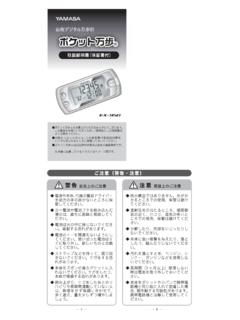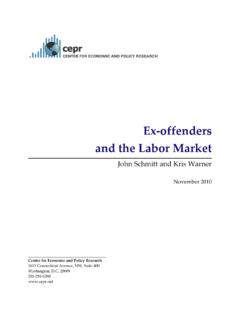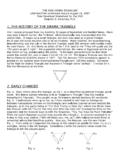Transcription of Ex-Ante Carbon-balance Tool (EX-ACT)
1 Ex-Ante Carbon-balance tool (EX-ACT). QUICK GUIDANCE. [PHOTO]. Ex-Ante Carbon-balance tool (EX-ACT). QUICK GUIDANCE. by Uwe Grewer, Louis Bockel, Laure-Sophie Schiettecatte (Agricultural Development Economics Division, FAO). and Martial Bernoux (Climate and Environment Division, FAO). Food and Agriculture Organization of the United Nations Rome, 2017. Cover photos: FAO/Munir Uz Zaman FAO/Olivier Asselin FAO/Joan Manuel Baliellas FAO/Giulio Napolitano The designations employed and the presentation of material in this information product do not imply the expression of any opinion whatsoever on the part of the Food and Agriculture Organization of the United Nations (FAO) concerning the legal or development status of any country, territory, city or area or of its authorities, or concerning the delimitation of its frontiers or boundaries. The mention of specific companies or products of manufacturers, whether or not these have been patented, does not imply that these have been endorsed or recommended by FAO in preference to others of a similar nature that are not mentioned.
2 The views expressed in this information product are those of the author(s) and do not necessarily reflect the views or policies of FAO. ISBN 978-92-5-130008-4. FAO, 2017. FAO encourages the use, reproduction and dissemination of material in this information product. Except where otherwise indicated, material may be copied, downloaded and printed for private study, research and teaching purposes, or for use in non-commercial products or services, provided that appropriate acknowledgement of FAO as the source and copyright holder is given and that FAO's endorsement of users' views, products or services is not implied in any way. All requests for translation and adaptation rights, and for resale and other commercial use rights should be made via or addressed to FAO information products are available on the FAO website ( ) and can be purchased through 1 Table of Contents Acknowledgements.
3 V Acronyms .. vi Executive summary .. vii Chapter 1. Quick guidance for decision makers .. 1. Introduction .. 1. Climate change mitigation in agriculture, forestry and fisheries .. 1. Why target GHG mitigation in agriculture, forestry and fisheries investment planning? .. 1. GHG accounting tools in agriculture .. 2. The Ex-Ante Carbon-balance tool .. 2. What is EX-ACT?.. 2. Tagert users .. 2. Basic structure of EX-ACT .. 2. Scenario 4. EX-ACT 5. Interpretation of the results .. 5. A case study from United Republic of Tanzania .. 6. Using the results .. 7. Chapter 2. Quick guidance for tool users .. 10. Methodology .. 10. EX-ACT data 10. Identifying the relevant EX-ACT modules for your 10. Overview of data requirements .. 11. Building the baseline scenario .. 14. Brief guide to entering data .. 14. Where to download and how to start .. 14. Navigation 14. EX-ACT colour codes.
4 15. Description Module .. 15. Data entry in the topic modules .. 16. References .. 18. iii Figures Figure 1. Visualising the development scenarios used in EX-ACT .. 4. Figure 2. The final Carbon-balance .. 5. Figure 3. Main EX-ACT 5. Figure 4. Exemplary results of an EX-ACT appraisal .. 6. Figure 5. Three baseline methodologies for creating a baseline scenario .. 14. Figure 6. EX-ACT navigation bar with the eight modules (green boxes) .. 15. Figure 7. EX-ACT colour codes .. 15. Figure 8. The Description Module .. 15. Figure 9. Deforestation (Land Use Change Module).. 16. Figure 10. Tier 2 specifications for deforestation .. 17. Tables Table 1. Some practical principles for the easy use of EX-ACT .. 3. Table 2. Break down of the smaller and up-scaled watershed components .. 7. Table 3. Budget and Carbon-balance of the two scenarios .. 7. Table 4. Checklist for identifying project relevant EX-ACT modules.
5 11. Table 5. Overview of Tier 1 activity data that can be accommodated in EX-ACT .. 13. iv Acknowledgements This Quick Guidance was prepared by Uwe Grewer, Louis Bockel and Laure-Sophie Schiettecatte from the Agriculture Development Economics Division (ESA) of the Food and Agriculture Organization (FAO) and Martial Bernoux from Climate and Environment Division (FAO) & the Institut de Recherche pour le D veloppement (IRD). Oscar Lozada provided editorial support for the text. Authors would like to acknolwdege the World Bank and the Institut de Recherche pour le D veloppement for the support they provided in developing the EX-ACT tool . v Acronyms AFOLU Agriculture Forestry and Other Land Uses CSA Climate Smart Agriculture EX-ACT Ex-Ante Carbon-balance tool FUI Fuel Use Intensity GHG GreenHouse Gas IFI International Financial Institution IPCC Intergovernmental Panel on Climate Change FAO Food and Agriculture Organization of the United Nations tCO2-e tonne of CO2 equivalents UNFCCC United Nations Framework Convention on Climate Change vi Executive summary This Quick Guidance material provides the reader with an overview and explanation of the methodology, data requirements, application and final use of the Ex-Ante Carbon-balance tool (EX-ACT).
6 It complements the more comprehensive EX-ACT User Manual that is designed to equip users with an independent and proficient understanding in the use of the tool . The Quick Guidance is composed of two chapters. Chapter 1, Guide for decision makers (10 pp.), discusses the rationale behind the tool , its utilization and its results. Chapter 2, Guide for tool users (8 pp.), introduces the more technical aspects of data collection, data entry and methodology. The Ex-Ante Carbon-balance tool is an appraisal system developed by FAO providing Ex-Ante estimates of the impact of agriculture, forestry and fishery development projects, programmes and policies on the Carbon-balance . The Carbon-balance is defined as the net balance of all greenhouse gasses (GHGs), expressed in carbon dioxide (CO2) equivalents, that were emitted or sequestered due to project implementation as compared to a business- as-usual scenario.
7 EX-ACT is a land-based accounting system, estimating carbon stock changes ( emissions or sinks of CO 2) as well as GHG emissions per unit of land, expressed in equivalent tonnes of CO2 per hectare and year. The tool helps project designers to estimate and prioritize project activities with the greatest economic benefit and potential for climate change mitigation. This GHG mitigation potential may also be used for economic analyses and for allocating additional project funds. The tool can be applied on a wide range of development projects in all Agriculture, Forestry and Other Land Use (AFOLU) sub-sectors, as well as other projects concerned with climate change mitigation, watershed development, production intensification, food security, livestock, forest management or land use change. Furthermore, it is cost effective, requires a comparatively small amount of data, and is equipped with useful resources such as tables, maps and FAOSTAT data.
8 While EX-ACT is mostly used at project level it can easily be scaled up to the programme or sector level and can also be used for policy analysis. EX-ACT is based on Microsoft Excel (without macros) and is freely available from the FAO website. EX-ACT Website: Free tool Access: EX-ACT User Manual & EX-ACT Quick Guidance: vii Chapter 1. Quick guidance for decision makers Introduction This Quick Guidance material is composed of two chapters: The first is chapter, Quick guidance for Decision Makers (10 pp.), which discusses the rationale behind the tool , its utilization and its results. The second chapter, Quick Guidance for tool Users (8 pp.), introduces more technical aspects of methodology data collection and data entry. Quick guidance for decision makers Section 2 discusses the importance of targeting climate change mitigation in agricultural investment planning.
9 It presents central facts to demonstrate the significance of agriculture sectors ( crops, livestock, forestry and fisheries) as sources of carbon emissions and the potential therein for climate change mitigation. Subsequently Section 3 briefly presents the Ex-Ante Carbon-balance tool in its most essential characteristics. Section 4 then describes the types of results obtained by EX-ACT and demonstrates how to use them for designing projects and prioritizing selected investments. Section 5 summarises the advantages of engaging in Carbon-balance appraisal and of using the EX-ACT tool . Quick guidance for tool users Section 6 then describes the methodology employed by EX-ACT, followed by a description of its primary data requirements (Section 7) and the process for building a baseline scenario (Section 8). Lastly, users are provided with a short guide to entering data (Section 9).
10 Climate change mitigation in agriculture, forestry and fisheries Why target GHG mitigation in agriculture, forestry and fisheries investment planning? Agriculture, Forestry and Other Land Uses (AFOLU) contribute around 25 percent of global anthropogenic emissions, primarily through deforestation, livestock emissions and soil and nutrient management. Annual GHG. emissions (mainly CH4 and N2O) from agricultural production in 2000-2010 were estimated at about GtCO2-e per year, or 10-12 percent of global anthropogenic emissions. Similarly GHG emissions from forestry and land-use change activities account for about tCO2-e per year, or 9-11 percent of total anthropogenic emissions (Smith et al., 2014). Furthermore, recent attention has focused on the high rates of annual carbon sequestration in vegetated coastal ecosystems (such as mangroves, marshes and seagrasses) that may be lost through habitat conversion.

















